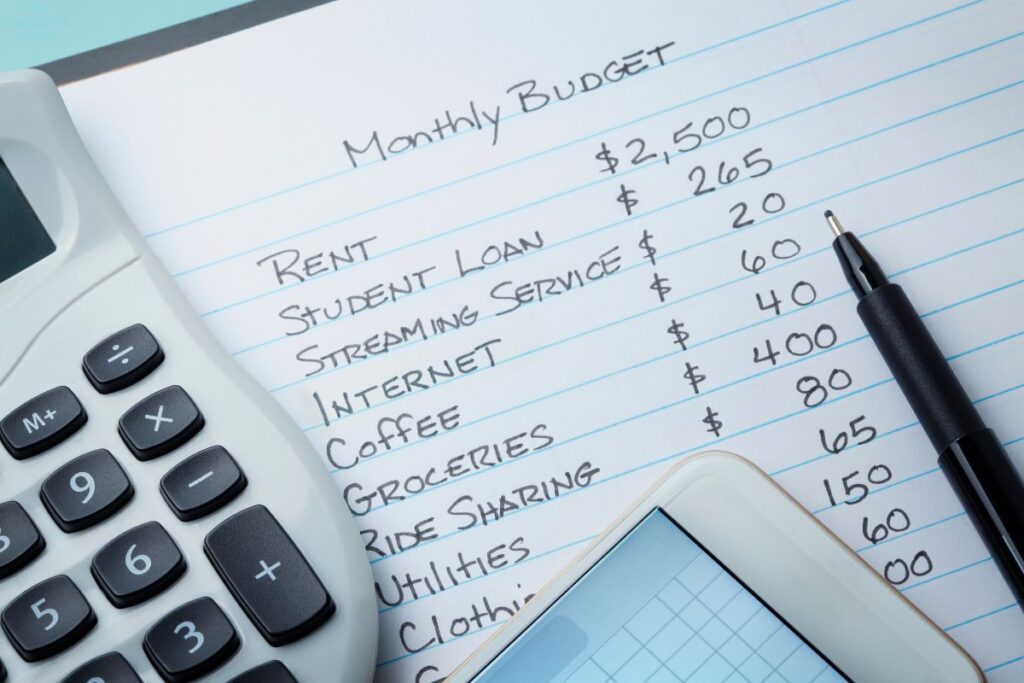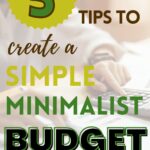Inside: Use these tips to create a simple minimalist budget to help get your finances back on track.
A guest post by Miguel of The Simple Paradise
Are you looking to create a minimalist budget and improve your budgeting!?
Creating a minimalist budget will help you simplify your budgeting process and make your life a lot easier.
Before using a budget, I had no idea how much money I was spending.
I had no intentionality with my financial decisions and lost out on a whole lot of savings that was wasted on junk I didn’t need.
Once I implemented a budgeting system, my finances were transformed.
I’m now able to set goals each month for where I’d like to put my money and what financial obligations are a priority.
These monthly budgeting decisions can include the following:
- Allocating money to your emergency fund
- Putting money towards your debt
- Investing in stocks or personal retirement accounts
- Saving money towards goals like a new house, car, or vacation
My hope is that these tips for creating a minimalist budget can make living on a budget a bit easier by helping you manage your money with intention so you can reach your financial goals.

What is a Minimalist Budget?
A minimalist budget is a simple budgeting method that is easy to use and allows you to save more while simplifying your life in the process.
Its purpose is to simplify your monthly budgeting and make it easier to manage your money.
Why Use a Minimalist Budget?
A minimalist budget, as well as a minimalist lifestyle, can help you save more and manage your money better by adding intentionality to your weekly and monthly financial decisions.
This allows you to meet different financial goals for yourself or your family:
- Family vacation
- Purchase a home
- Save for retirement
How Much Money Do Minimalists Save?
Minimalists typically save money in a variety of categories:
- Clothes shopping
- Dining out
- Random shopping
- Buying because of wants
- Impulse purchases
A minimalist lifestyle allows money to be saved in these categories which could add up to $100-$300 of your monthly budget.
You might be surprised how much money living simply can save you in a year.

How to Create a Simple Minimalist Budget (5 Easy Tips)
Use these practical budgeting tips to create your simple minimalist budget.
1. Simplify Your Finances
When simplifying our finances, we want to maximize practicality while simultaneously minimizing and consolidating our personal finances.
But how do we do this?
First: Take action to get rid of the fluff. Taking steps to simplify your finances includes getting rid of any bank accounts you barely use or that serve no function.
This includes:
- Checking accounts
- Savings accounts
- Investment accounts
- Consolidating loans
If you have investments in a Vanguard account and Fidelity, just put them all on one platform unless you have different functions for each account.
Likewise, get rid of extra savings accounts that don’t serve any particular purpose.
A nice example of a simplified financial setup could include:
- 1-3 checking/savings accounts
- 1-3 credit cards (don’t use credit cards if you can’t handle it)
- 1 brokerage account (Vanguard)
This is just a starting point and can be expanded upon if it fits your needs, but it’s a good start.
You could also minimize this setup further if you wanted.
Furthermore, for your checking account, it’s helpful to have a main account where most of your money flows initially from your paycheck or income source.
Next, it’s beneficial to open a high-yield savings account and create an emergency fund with a different bank.
This keeps your spending account and emergency finances separate so that you aren’t tempted to use any of it.

2. Choose Your Ideal Budgeting Method
Once you’ve set your foundation for your minimalist finances, you’re ready to choose an ideal budgeting method.
There are tons of ways to budget your money and there’s no right or wrong way to go about it.
However, you must choose a minimalist budgeting method that works best for your situation and preferences.
Here are some common budgeting methods:
- Pencil and paper from scratch
- Budget printable
- Budgeting app
- Excel/Google Sheets Spreadsheet
Ultimately, you’ll want to pick a budgeting method that you can stick with and that actually works for you every month.

3. Create Custom Categories
Now that you’ve chosen your preferred budgeting method, you need to actually set up your minimalist budget and create the categories you’d like to track.
Ideally, you want to create your categories based on your needs. I recommend creating main categories and using subcategories.
Here is an example of minimalist budget categories with subcategories:
- Home
- Rent
- Mortgage
- Insurance
- Repairs
- Food
- Groceries
- Restaurant
- Delivery
- Auto
- Gas
- Repairs
- Car Wash
- Parking
- Utilities
- Phone bill
- Electric
- Water
- Internet
- Insurance
- Auto
- Health
- Miscellaneous
- Fun activities
- Shopping
- Entertainment
- Savings
- Emergency fund
- Vacation fund
- Short-term
- Long-term
- Investments
- Roth IRA
- Traditional IRA
- Taxable Investment account
- Debt
- Credit card
- Student loans
- Car loans
This type of budget category setup is good for identifying where your spending is going for specific categories.
However, this is just an example, and you can opt to simplify it further.
If you don’t mind keeping your categories broad, you could simply remove the subcategories and just keep the main categories.
With this approach, it can be helpful to keep it simple, but it also may hinder your ability to track where a lot of your problem spending areas are.
The 50/30/20 Rule
The 50/30/20 rule is great for beginners and is a target for allocating your money each month.
The rule allows you:
- 50% for needs
- 30% for wants
- 20% for savings/debt
It’s not perfect but it’s a good guideline to get you started.

4. Create a Practical Budgeting System
Once you’ve set up your budget and are ready to get going, it’s time to make sure you have a system that you can implement that not only works but that you can sustain.
Here are some ways you can keep up with your budget:
- Keeping receipts
- Going through your statements
- Using a budgeting app like YNAB
- Recording your expenses on your phone
- Reviewing your budget after every paycheck
- Reviewing your budget after weekly/biweekly
These are some common ways to enter in your expenses and income, but feel free to come up with any type of method or combination of methods that works well for you.
I use a combination of receipts and recording online purchases on my phone reminders and notes.
Then I go to my budget spreadsheet and enter in all of the values. I find this method to be very effective, but for someone using a budgeting app, this may not be necessary.

5. Test What Works Best For You
Now that you’re ready to start budgeting, you need to pick your budgeting method and experiment with what will work best for you.
Again, you must choose something you can stick with and sustain in the long run.
There’s no point putting in the effort to budget and track your expenses for a few weeks and then completely stop just because the process is too tedious for you.
You need something easy and repeatable.
For instance, budgeting from scratch can seem easy at first but could get really stale if you have to constantly write out everything each month.
In order to get the most from your budget you want something where you can easily enter the information so you can see where your money is going.
By constantly staying on top of the numbers you can slow money drains that maybe you hadn’t realized were happening and regain control over your finances.

Extreme Minimalist Budget
Creating an extreme minimalist budget can be another way to simplify your budgeting and make it even easier!
An extreme minimalist budget can consist of fewer categories, tighter spending limits, an extreme minimalist mindset to cut costs wherever possible, and a simplistic method.
Think of a budget broken down like the 50/30/20 budget or a budget that has two categories:
- “Wants” and “Needs”
- Bills and Miscellaneous
- “Essentials” and “Extra”
With an extremely minimalist budget like this with two categories, you can easily put all of your expenses under each and categorize them as such.
This makes it easy to determine the needed expenses and how much you may be spending on wants.
Minimalists focus on repairing instead of replacing what they have when possible.
They also believe that there are better things you can do with your money than just buying more stuff.
Final Thoughts on How to Create a Simple Minimalist Budget
Creating a minimalist budget will help you financially in so many ways!
I highly recommend tracking all of your expenses and planning where your money will go each month.
While you may not be able to control what everything costs, being aware of what you’re spending and having a plan will help you to feel like the master of your financial destiny instead of a debt slave living paycheck to paycheck.
I hope this was helpful and can get you on the right track financially.
Happy budgeting! 🙂

About Me: My name is Miguel and I’m a simple living and budget spreadsheet advocate! I have a degree in communications from Penn State and enjoy writing. I’ve been decluttering my life since 2018 and love everything simple living related. I aim to help you learn how to live a simple life, become intentional with your spending, and manage your money right!
Do you have a simple minimalist budget? Let us know in the comments section below.
Sign up on the form below to get weekly decluttering and simplifying inspiration sent straight to your inbox. You’ll also get the free 8 Quick Wins for Decluttering Worksheet to help you start to simplify your life today.

